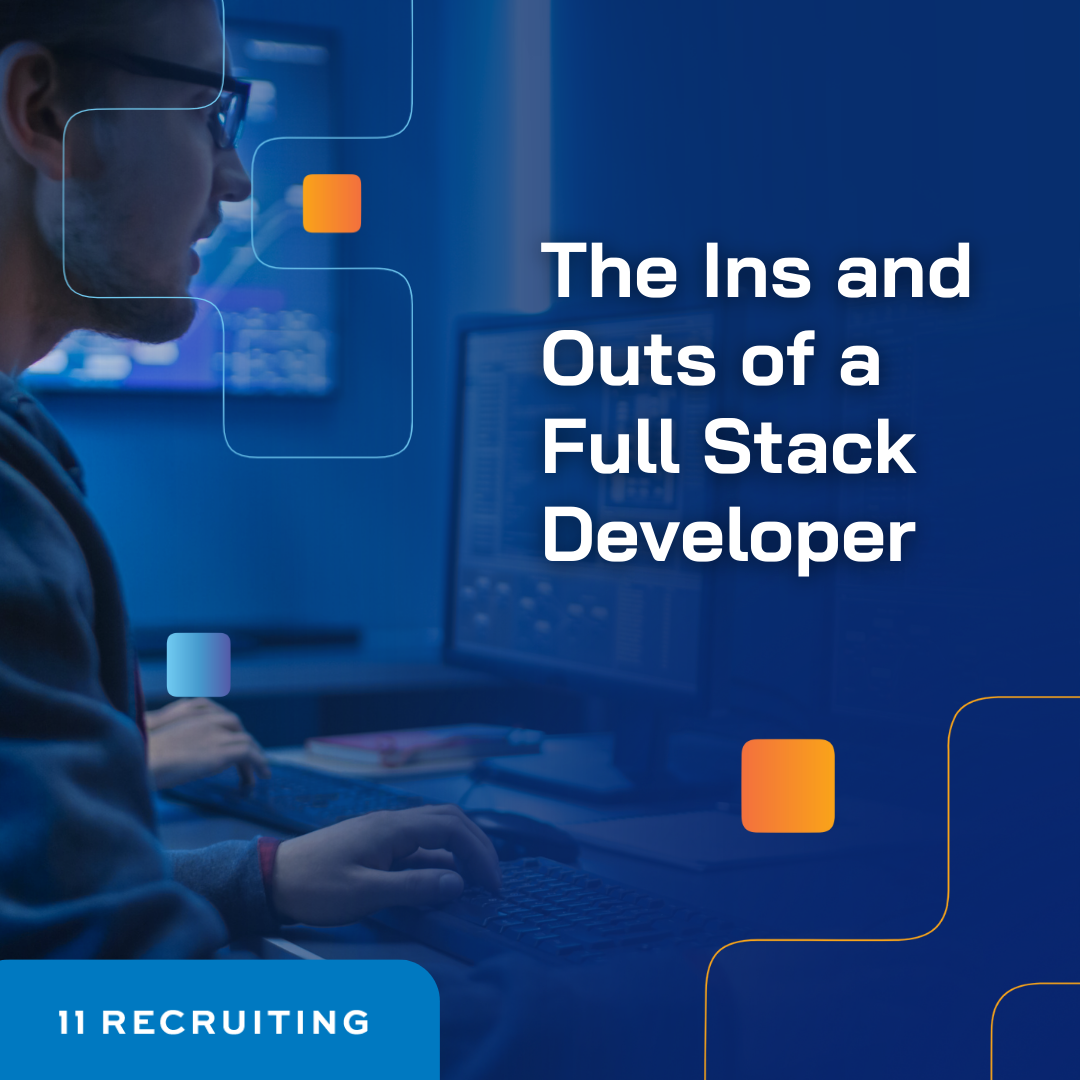
Do you need to recruit a developer who can work on front-end and back-end projects, database management, and deployment? Consider hiring a full-stack developer. Because of their wide variety of talents and ability to manage numerous duties simultaneously, these versatile tech workers have become a coveted commodity in the market.
In this post, we’ll look at what it means to be a full-stack developer, the abilities required to become one, and why they’re crucial to any firm. Hence, if you want to employ or become a full-stack developer, keep reading to discover everything there is to know about this exciting and in-demand career.
What is a Full-Stack Developer?
A full-stack developer is a tech specialist knowledgeable in front-end and back-end development, database management, and deployment. In the computer business, they are sometimes referred to as “jacks of all crafts,” They are highly prized for their versatility and ability to manage a wide range of duties.
A full-stack developer must have diverse skills, including knowledge of programming languages such as JavaScript, HTML, CSS, and SQL. Knowledge of frameworks such as React, Angular, Node.js, and Django is also required.
Skills of Full-Stack Developer in Front-end Development
Front-end development is critical in creating a user-friendly and visually appealing website or application. It involves designing and building the interface that users interact with and ensuring that it is intuitive and easy to navigate.
A full-stack developer skilled in front-end development can create engaging and responsive user interfaces that enhance the user experience. They can also ensure that the website or application is optimized for different devices, including desktops, tablets, and mobile devices.
Skills of Full-Stack Developer in Back-end Development
Back-end development is an important part of a full-stack developer’s skill set. It entails developing and maintaining the server-side element of a website or application, which includes the database, server, and application logic.
Back-end development ensures a website or application runs smoothly and efficiently. It includes building and administering databases, implementing security measures, and optimizing server performance.
A full-stack developer with back-end development experience can construct robust and scalable systems that handle massive data and traffic volumes. They can also ensure the application’s security, dependability, and ease of maintenance.
Databases and Data Structures
Understanding databases and data structures is critical for designing efficient and scalable applications as a full-stack developer. So let’s dig deeper into these issues’ significance in full-stack development.
Databases serve as the foundation for most modern applications, allowing developers to store and handle vast volumes of data. In full-stack development, numerous types of databases are employed, including:
- Relational Databases: store data in tables with a predetermined schema, allowing for efficient querying and data manipulation using SQL.
- NoSQL Databases: store data in a flexible, schema-less format, allowing for more dynamic data modeling and speedier performance in specific use cases.
- Graph Databases: store data in a graph format, making it easier to query and analyze more complicated relationships between data points.
In computer science, data structures are the foundation for organizing and storing data. They improve an application’s performance by allowing faster data access and editing. The following data structures are frequently used in full-stack development:
- Arrays: Arrays are collections of elements of the same kind stored in a single contiguous memory block. They are often used for data indexing and random access.
- Linked Lists: A linked list is a collection of pointers-connected nodes. They are often utilized for dynamic memory allocation and efficient element insertion and deletion.
- Trees: Trees are hierarchical data structures used to express relationships between items. They are frequently used for data searching, sorting, and organization.
Deployment and DevOps
Deployment is releasing an application to a live server or production environment. Configuration, testing, and optimization are all part of the process. DevOps, on the other hand, refers to a collection of methods and technologies used to automate the deployment process and ensure that the application operates smoothly in production.
Full-stack developers employ various tools and technologies to speed up the deployment process. Among these tools are Git, Jenkins, Docker, and Kubernetes. In addition, they use scripting languages such as Bash and Python to automate the deployment process and ensure that everything works well.
Soft Skills for Full-Stack Developers
Being a full-stack developer necessitates technical talents and soft skills for industrial success. The following are some of the most critical soft skills for full-stack developers to have:
Communication
Full-stack developers collaborate with various people, including designers, project managers, and clients. Therefore, they must interact successfully with each stakeholder to ensure everyone is on the same page. This entails accurately expressing technical topics and being an attentive listener capable of understanding the wants and concerns of others.
Time Management Skills
Full-stack developers are frequently in charge of controlling their own time and ensuring that projects are completed on time. This necessitates exceptional time management abilities, such as prioritizing activities, handling distractions, and retaining concentration on the most critical initiatives.
Collaboration and Teamwork Skills
Full-stack development is rarely done alone. Full-stack developers must be able to collaborate with others, both within and outside of their teams. This includes actively contributing to group conversations, giving and receiving constructive comments, and working toward common goals.
Benefits of Becoming A Full-Stack Developer
The demand for competent people who can keep up with the ever-changing world of software development grows in lockstep with technological advancement. As a result, a full-stack developer is one of the most adjustable positions in the computer world today. This hybrid position combines front-end and back-end development knowledge and ability, as well as proficiency in other essential areas of software development.
The following are some of the benefits of adopting this intriguing career path:
- Versatility: Full-stack developers have diverse technical talents, making them significant assets to any firm or project. Because of their adaptability, full-stack developers can work on various projects and play multiple roles within a team.
- Improved employability: Full-stack developers are in high demand in the job market due to their diverse skill sets.
- Increased autonomy: Full-stack engineers understand the software development process more thoroughly, so they can work independently and take control of their work. This level of independence can lead to better job satisfaction and a sense of accomplishment.
- Competitive salary: Full-stack developers might fetch higher wages than other software developers due to their unique talents.
- Constant learning: Because full-stack development is an ever-changing area, developers must keep up with the latest technologies and tools.
Are you looking for excellent full-stack developers to help your company reach new heights? There is no need to look any further! Visit our page to see all of the fantastic open roles we have. We’re not just here to assist you in locating top talent; we’ll also walk you through the hiring process to ensure you get the best. Our network and industry knowledge are ready to help you and your company. So, what are you holding out for? Contact us today to get started on assembling your dream team!
Frequently Asked Questions
What is the workload of a full-stack developer?
A full-stack developer’s workload can vary based on the project and company. They oversee front-end and back-end development, database management, deployment, and maintenance. For people who appreciate working on all areas of a project, it can be tough but also gratifying.
What are the responsibilities of a full-stack engineer?
Your responsibilities as a full-stack engineer include designing and maintaining both front-end and back-end systems, managing databases, ensuring efficient deployment, and diagnosing any problems that may emerge. Therefore, you must be well-versed in numerous programming languages and frameworks and adapt to new technologies and tools. Eventually, you want to design smooth and functional apps that suit the needs of users and clients.
What are the hot skills for a full-stack developer?
A full-stack developer should be proficient in numerous programming languages such as JavaScript, Python, and Java, as well as front-end and back-end frameworks such as React, Angular, and Node.js. Understanding of database management systems such as MySQL, MongoDB, and PostgreSQL, as well as expertise with DevOps tools such as Docker and Jenkins, is also required. In this ever-changing sector, keeping up with emerging technology and being flexible to new tools is essential.
How to Build a Full-Stack Development Team for Your Business
You can take various steps to apply full-stack development expertise to yourself or your organization.
- Assess your current skill set: Analyze your present technical skills and determine which areas you need to work on to become a full-stack developer.
- Study new programming languages and frameworks: To become a full-stack developer, you must be proficient in various languages and frameworks. Learn new skills and keep up with the latest trends by taking courses or online tutorials.
- Develop database management expertise: Full-stack developers must thoroughly understand database management. Take courses or obtain hands-on experience with database administration technologies to improve your abilities.
- Understand deployment and DevOps tools: Knowing deployment and DevOps technologies is essential for streamlining development. Learn about popular tools like Docker, Jenkins, and Kubernetes.

